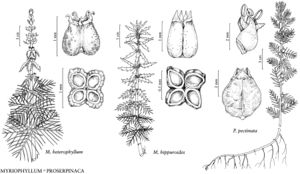Myriophyllum heterophyllum
Fl. Bor.-Amer. 2: 191. 1803.
Herbs monoecious, aquatic, often forming dense stands. Stems often branched, to 2.5 m. Turions absent. Leaves usually in whorls of 4 (–6), often subverticillate, sometimes alternate, heteromorphic; petiole to 5 mm; submersed leaves pectinate, ovate to obovate in outline, (6–) 12–29 (–65) × (12–) 14–18 (–50) mm, segments (10–) 12–20 (–28), linear-filiform, longest segment (7–) 9–25 (–29) mm; emersed leaves pectinate to pinnatifid proximally, lanceolate to ovate or elliptic distally, 3–14 (–31) × 1–5 (–7) mm, margins serrate to lobed. Inflorescences to 60 cm; flowers proximally pistillate, medially bisexual, distally staminate; bracteoles cream, ovate to triangular or deltate, 0.6–1.1 ×0.3–0.9 mm, margins serrate to irregularly lobed. Staminate flowers: sepals cream, lanceolate to narrowly triangular, 0.5–0.8 (–0.9) × 0.1–0.2 mm; petals persistent, cream, elliptic to obovate, 1.4–3 × 0.7–1.3 mm; stamens 4, filaments to 1.6 mm, anthers 1.3–2.2 × 0.3–0.7 mm. Pistillate flowers: sepals cream, triangular, (0.1–) 0.2–0.6 × 0.1–0.3 (–0.4) mm; petals caducous, cream, elliptic to obovate, 1.5–2 (–3) × 0.8–1 mm; pistils 0.8–1.7 mm, stigmas red to ± purple, to 0.4 mm. Fruits ovoid to subglobose, deeply 4-lobed. Mericarps tan to redbrown, cylindric to narrowly ovoid, 1–1.5 ×0.5–0.8 mm, transversely orbiculate to widely elliptic, abaxial surface bluntly 4-angled, rounded to slightly flattened, densely papillate, with 4 shallow, longitudinal ridges, ridges sometimes with inconspicuous, shallow wings proximally, ribs absent.
Phenology: Flowering and fruiting May–Oct.
Habitat: Oligotrophic to eutrophic waters, lakes, ponds.
Elevation: 0–600 m.
Distribution
B.C., N.B., Ont., P.E.I., Que., Ala., Ark., Conn., Del., D.C., Fla., Ga., Ill., Ind., Iowa, Kans., Ky., La., Maine, Md., Mass., Mich., Minn., Miss., Mo., N.H., N.J., N.Y., N.C., Ohio, Okla., Pa., R.I., S.C., Tenn., Tex., Vt., Va., Wash., W.Va., Wis.
Discussion
In flower, Myriophyllum heterophyllum is one of the more distinctive water-milfoils; it has relatively large, wide, ovate bracts and elongate spikes, on which leaves transition from pectinate to entire and often trail along the water surface. Plants are often very robust and bushy, with thickened red stems and highly crowded leaf whorls.
D. H. Les and L. J. Mehrhoff (1999) suggested that Myriophyllum heterophyllum is invasive in New England and progressively spread northward from a more southern native range. It is known to be introduced in British Columbia. R. A. Thum et al. (2011) provided genetic evidence that invasive populations of M. heterophyllum from New England, the Pacific Northwest, and California represent multiple introductions from the native Atlantic coastal plain and interior continental range.
S. G. Aiken (1981) suggested that Myriophyllum heterophyllum produces turions; we have seen no evidence of this, and it is likely that new shoots produced along rhizomes late in the growing season have been mistaken for turions.
Selected References
None.
